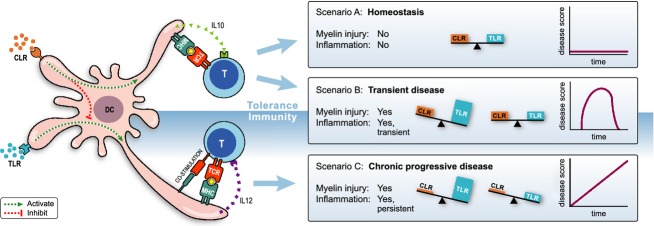Figure 2.

Yin-Yang regulation of myeloid APC. Depicted is a myeloid APC, for example, a microglia or dendritic cell, which expresses C-type lectin (CLR) and toll-like receptors (TLR). Via the integration of inhibitory input signals via CLR and stimulatory input signals via TLR the APC is instructed whether it needs to display tolerogenic or immunogenic activity. In a healthy brain APC are in a tolerogenic state as danger signals received via TLR are counterbalanced by inhibitory signals via CLR, for example, binding of normally glycosylated MOG to DC-SIGN (scenario A). CNS infection or tissue damage induces increase in danger signals, resulting in a, CLR/TLR dysbalance and maturation of APC to an immunogenic state. When the danger signals are cleared, the CLR/TLR balance that maintains homeostasis is restored (scenario B). When scenario B occurs in inflamed tissue where normal glycosylation is disturbed resulting in impaired CLR signaling, return to homeostasis after clearance of the danger does not occur. APS, antigen presenting cell; CNS, central nervous system; DC, dendritic cell.
